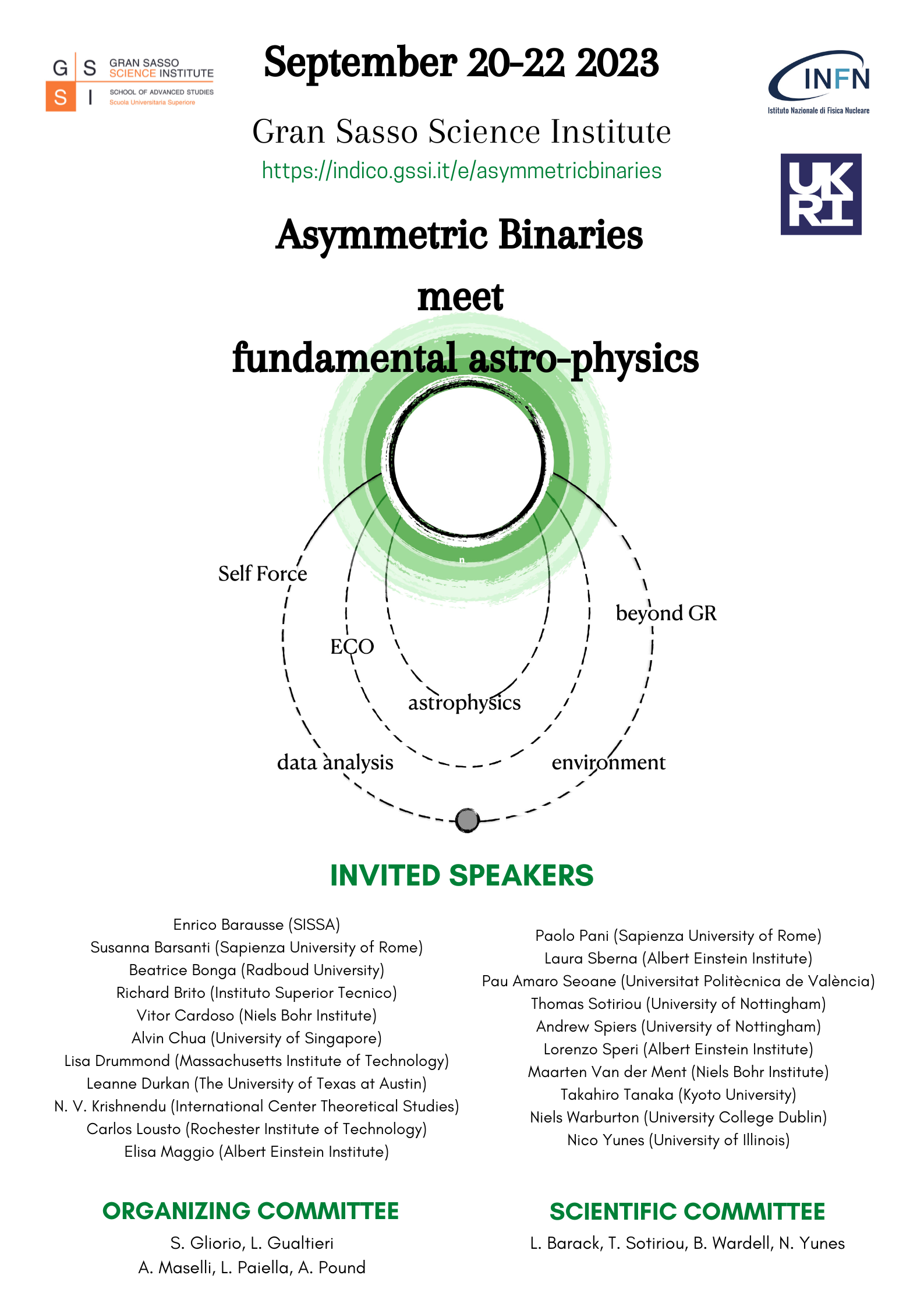Asymmetric Binaries meet Fundamental Astro-Physics
GSSI
Gravitational wave observations of binary mergers are carrying a new revolution in astrophysics. While signals detected by ground based detectors have already shed light on the most violent among astrophysical events, next generation of interferometers like LISA will allow to witness the evolution of new families of sources, as asymmetric binaries, which harbour a unique potential for the identification of new fundamental fields and particles.
The workshop “Asymmetric Binaries Meet Fundamental Astro-Physics” builds around 5 topics connected to these compact sources: self-force methods, beyond GR modelling, Exotic Compact Objects, environmental effects, astrophysics and data analysis approaches.
The goal of the meeting is to discuss the most recent advances in these topics and their relevance to probe astrophysical and fundamental physics scenarios. We aim to foster multi-disciplinarity among the various themes.
The workshop will be held at the Gran Sasso Science Institute in L’Aquila, from September 20-22, 2023.
L’Aquila lives in a beautiful environment surrounded by the highest peaks of the Apennine Mountains of Italy. The city is home to art, history, and great food.
Invited Speakers
Enrico Barausse (SISSA)
Susanna Barsanti (Sapienza University)
Beatrice Bonga (Radboud University)
Richard Brito (Instituto Superior Tecnico)
Vitor Cardoso (Niels Bohr Institute)
Alvin Chua (University of Singapore)
Lisa Drummond (Massachusetts Institute of Technology)
Leanne Durkan (The University of Texas at Austin)
N. V. Krishnendu (International Center for Theoretical Studies)
Carlos Lousto (Rochester Institute of Technology)
Elisa Maggio (Albert Einstein Institute)
Maarten van de Meent (Niels Bohr Institute)
Paolo Pani (Sapienza University)
Gabriel Piovano (University College Dublin)
Laura Sberna (Albert Einstein Institute)
Pau Amaro Seoane (Universitat Politècnica de València)
Thomas Sotiriou (Nottingham University)
Lorenzo Speri (Albert Einstein Institute)
Andrew Spiers (Nottingham University)
Takahiro Tanaka (Kyoto University)
Niels Warburton (University College Dublin)
Nico Yunes (University of Illinois)
Organizing Committee
Sara Gliorio, Leonardo Gualtieri, Andrea Maselli, Lavinia Paiella, Adam Pound
Scientific Committee
Leor Barack, Thomas Sotiriou, Barry Wardell, Nico Yunes

Abhishek Chowdhuri
ADNAN MALIK
Adriano Frattale Mascioli
Andrea Maselli
Andrew Spiers
Benjamin Leather
Boris Goncharov
Carlos Lousto
Christopher Whittall
Diganta Bandopadhyay
Emmanuele Battista
Gabriel Andres Piovano
Gaetano Lambiase
Geoffrey Compère
Gianluca Grignani
Gianluca M Guidi
Giorgio Mentasti
Giovanni Maria Tomaselli
Giuliano Iorio
He Wang
Jayashree Saha
KRITTIKA SARKAR
Kyriakos Destounis
Lami Suleiman
Lavinia Paiella
Loris Del Grosso
Marco Immanuel Rivera
Marta Colleoni
Matteo Della Rocca
Mattia Emma
Nicholas Loutrel
Nicholas Speeney
Philip Lynch
Prasad R
Rhondale Tso
Richard Brito
Roberto Oliveri
Rodrigo Panosso Macedo
Sakshi Madekar
Sara Motalebi
Sayak Datta
Shailesh Kumar
Shrobana Ghosh
Suvodip Mukherjee
Ulyana Dupletsa
Valerio De Luca
Violetta Sagun
Yan LIU
Zachary Nasipak
Zenia Zuraiq
- +23
